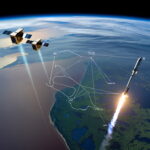Engineers at UNSW Sydney have taken a major step toward scalable quantum computing by successfully creating “quantum entangled states” using the spins of two atomic nuclei. Entanglement, a phenomenon where particles become inseparably linked, is a key resource that could allow quantum computers to surpass the power of classical machines.
The breakthrough, published in Science, demonstrates that nuclear spins—implanted in silicon using phosphorus atoms—can now interact over practical distances. According to lead researcher Dr. Holly Stemp, this milestone shows how quantum microchips could be built with manufacturing technology already standard in today’s semiconductor industry.
Traditionally, atomic nuclei have been valued for their stability but were difficult to connect over larger scales. The UNSW team overcame this by using electrons as mediators, effectively acting as “telephones” between nuclei. This allowed two nuclei, separated by 20 nanometers—roughly one-thousandth the width of a human hair—to communicate. Scaled up, this distance would be comparable to Sydney and Boston apart.
Professor Andrea Morello, who has led UNSW’s nuclear spin research for over 15 years, said the work removes a major barrier to scaling quantum processors. “We showed that the cleanest, most isolated quantum objects can now talk to each other at the same scale as today’s silicon devices. This means we can harness existing chip-making methods to build quantum computers.”
By making quantum systems compatible with current chip manufacturing, this achievement paves the way for large-scale, reliable quantum computers. The next phase will focus on extending entanglement to more nuclei, further demonstrating scalability.
UNSW Scientists Achieve Quantum Entanglement Breakthrough Using Atomic Nuclei in Silicon Chips






